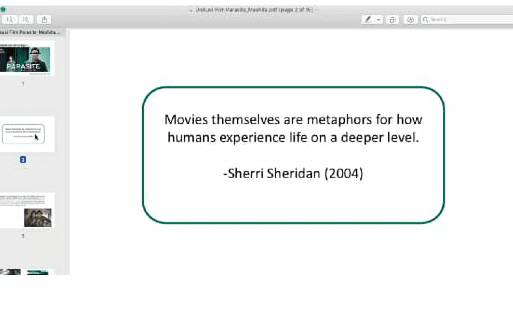
Yogyakarta, May 8th 2020 – The ‘Parasite’ movie mustn’t be unfamiliar again for us. The thriller/comedy film was directed by Bong Joon-ho who just received four awards at Oscar. Still with his trademark, director Bong Joon-ho slipped messages full of social criticism into his film through symbols. In order to discuss messages and symbols in ‘Parasite’ movie, Career Development Center or CDC FISIPOL UGM held a film discussion webinar titled “Uncovering Meaning and Symbol in ‘Parasite’ Movie” with Mashita Fandia, lecturer in the Department of Communication Science UGM.
Webinar held on Webex was moderated by Alfira Nuarifa, CDC staff, as ‘host’. Started at around 03.00 p.m., this webinar started with a summary of the film by the ‘host’ and continued with discussion by Mashita as the discussion starter.
Mashita explained that messages about social criticism that director Bong Joon-ho tries to deliver can already be seen on the film poster. If you pay close attention, there is a difference in color between Kim family’s censor line and Park family’s with the latter being white and the other is black. That difference showed the satire that director Bong Joon-ho tries to deliver; that there is a dichotomy between “the rich” and “the poor”. In this capitalist society, the rich are placed in the white position and the poor in black.

Other than that, the social criticism can also be seen from the characteristics of the film characters. Members of the Park’s family are relatively younger than Kim’s. This difference implies a meaning that the rich will be richer and the poor will be poorer. Doesn’t matter how many years they work, Kim’s family’s wealth will never come close to Park family’s. This satire message also tried to be delivered through the film’s end credit song, that the title translated literally to “564 Years”, telling that hundreds of years are needed for Ki-woo to make money to buy Park’s family’s house.
That implied message showed that the inequality that director Bong Joon-ho tried to deliver in this film is different than his past film, Snowpiercer. Even though oftentimes preached as two parallel films that address inequality, Snowpiercer is addressing horizontal inequality or hallway that is symbolized with train, meanwhile Parasite is addressing vertical inequality or stairway.
The unique thing is, Parasite is also touching on conflicts between lower class a little bit. Two groups of lower class, Kim’s family and Park family’s maid are squabbling trying to survive. That squabble didn’t give any impact on the upper class, Park’s family. Conflicts between lower class also showed through their different approach in dealing with financial problems. Mashita mentioned an article in The Jakarta Post that said Park’s family’s maid has some kind of prestige over a “title” of being a model maid that never bothered their employer. This prestige comes because she already works in the house that Park’s family lives in since the past owner of the house. To maintain her prestige she chose to borrow money to loan shark instead of her employer.
Other symbols also discussed in this webinar, like rock that believed to be the first source of life; inequality between the rich and the poor in dealing with rain; The “ramdon” that are meal for everybody, especially lower class, but cooked with expensive steak; “smell” that are identical with the lower class because perfume is a luxury item; and dialogs that are adjusted so the film can be understand universally.
The “parasite” terminology in this film is shown in the two classes, the lower and upper class. The lower class is a parasite to the upper class because they depend on the upper class for their living. And the upper class is a parasite to the lower class because they depend on the lower class’s labor. Mashita explained that all characters in this film are essentially a “parasite”. And the reality is, that thing is reflected in our daily life in this era of late capitalism; that everyone is a “parasite”.
Discussion ended at about 05.00 p.m. after Mashita answered all the questions that the webinar participants asked. In the end, Mashita emphasized that any meaning from this film will come back to the spectator. And every one who watched this film, from wherever it is will interpret the symbols in this film contextually by seeing what is close to their everyday life.
